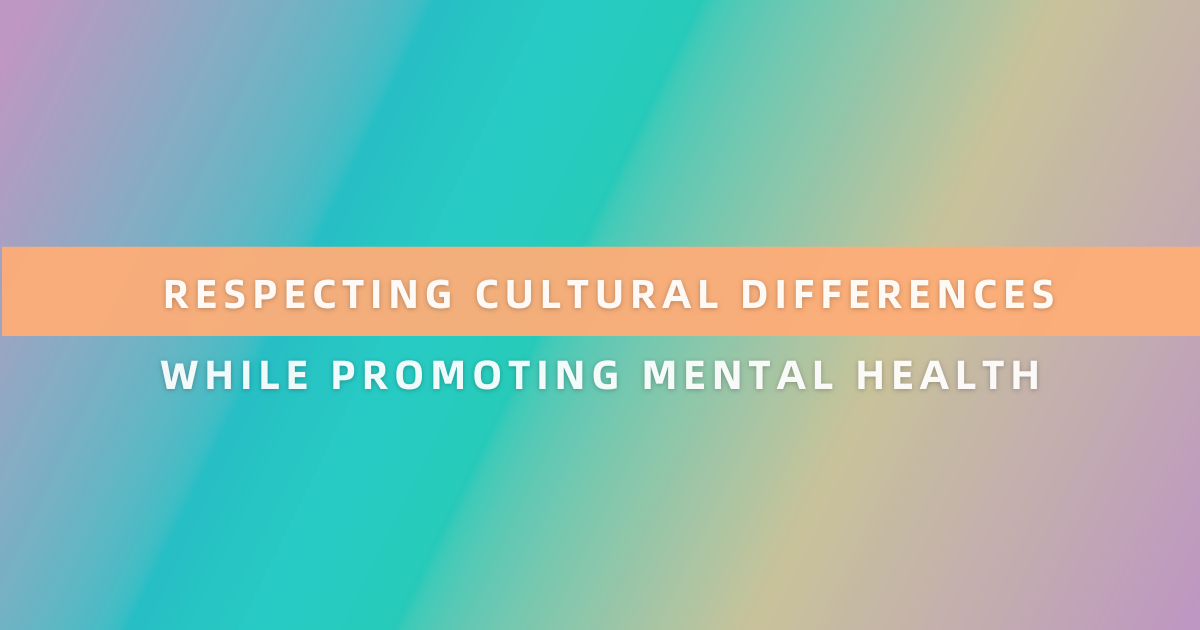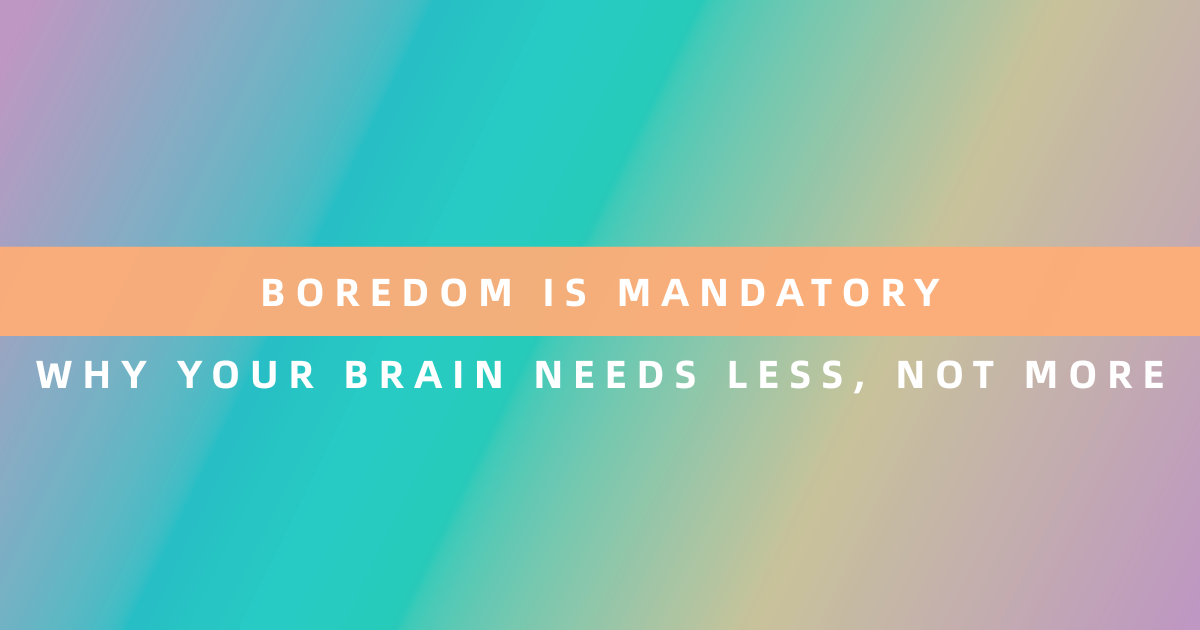Mental health advocacy often begins with good intentions, yet even the best intentions can lead to challenging situations when they clash with cultural beliefs. For example, you might suggest therapy to someone who is struggling, only to discover that in their community, mental distress is seen as a spiritual concern addressed through prayer, rituals, or traditional healing practices [1]. What seems like an obvious solution in our culture can feel inappropriate or even disrespectful in another.
This is where advocacy becomes complicated. Advocates want people to have access to adequate support, but they also want to respect traditions that have shaped families and communities for generations. It is a delicate balance. Pushing too hard risks erasing cultural values, while pulling back too much risks leaving people without the help they may urgently need.
The challenge grows in diverse settings, such as schools, workplaces, or neighborhoods, where multiple cultural frameworks intersect. One person may be open to counseling, while another may see it with suspicion. Some may prefer family involvement in every decision, while others may expect privacy and independence. This is why advocates must learn to respond to all these expectations simultaneously.
And it is natural to feel uncertain in these situations. You might wonder whether you are honoring a culture’s traditions or overlooking someone’s need for professional care. You may ask yourself whether you are being sensitive or allowing harmful stigma to continue. These are the kinds of dilemmas that arise whenever cultural differences and mental health needs intersect. However, the truth is that effective mental health advocacy does not require choosing between cultural respect and psychological support. It works within cultural frameworks, adapts to community needs, and builds trust through genuine engagement. Culture and mental health are not opposites. Recent discussions on culturally appropriate advocacy (CAA) also highlight that advocacy must go beyond cultural awareness to address the realities of race and racism within mental health systems. Protecting rights is essential, but true equity comes from advocacy that promotes the substantive rights of racialised communities and ensures fairer outcomes in both care and recovery [2].
Why One Size Fits All Mental Health Approaches Don’t Work
Traditional Western approaches to mental health promotion often assume that everyone shares similar values about individual autonomy, professional treatment, and psychological concepts. However, these assumptions can create barriers when working with communities that have different cultural frameworks for understanding mental and emotional well-being.
One key difference is how people perceive themselves. Many Western therapies emphasize personal growth, setting boundaries, and making independent choices. In contrast, cultures with a more collective focus may prioritize family involvement, harmony within the group, and community-based solutions. What feels empowering in one context can feel isolating or disrespectful in another.
Communication styles vary dramatically across cultures, affecting how people express distress, seek help, and engage with mental health support. Some cultures encourage direct communication about emotional struggles, while others rely on indirect communication, nonverbal cues, or symbolic expressions of distress that may not align with Western therapeutic models [3].
Authority and hierarchy influence how different cultures approach mental health treatment. Some cultures have a deep respect for elder wisdom and traditional healing practices, making it challenging for people to accept advice from young therapists or to adopt approaches that seem to contradict cultural authorities.
Spiritual and religious integration plays a central role in many cultural approaches to mental health, with healing practices that incorporate prayer, ritual, and spiritual guidance. Secular mental health approaches may feel incomplete or inappropriate to people whose cultures view psychological distress as inseparable from spiritual concerns.
Family and community involvement vary significantly across cultures. Some cultures expect families to be deeply involved in treatment decisions and healing processes, while Western approaches often emphasize individual privacy and autonomous decision-making that may conflict with cultural expectations.
Stigma and shame manifest differently across cultures, with some communities viewing mental health struggles as bringing shame to entire families or communities. This can make Western approaches to destigmatization ineffective or even counterproductive in certain cultural contexts.
Economic and resource considerations affect how different cultures approach mental health support. Many cultures have traditional healing practices that are more accessible and affordable than professional mental health services, making them practical as well as culturally appropriate to integrate.
Historical trauma influences how different cultural communities view mental health services, particularly when these services have been used as tools of oppression or cultural suppression in the past. This history can create legitimate mistrust that must be acknowledged and addressed.
How Different Cultures View Mental Health and Healing
Mental health is not defined the same way across cultures. Each community interprets distress and healing through its own history, beliefs, and practices. Looking at these perspectives more closely shows how different, yet equally valid, approaches to well-being can be.
Indigenous perspectives
For many Indigenous communities, mental health cannot be separated from spirituality, physical health, or community life. Distress is often seen as the result of disconnection from cultural practices, land, or ancestral ties. Healing tends to focus on restoring those connections through ceremonies, traditional medicine, and community gatherings. Instead of individual therapy, the emphasis is on collective healing that reinforces identity and a sense of belonging.
East Asian perspectives
In East Asian traditions, balance and harmony are central. Mental health is often understood through frameworks such as Traditional Chinese Medicine, which views distress as a disruption in the flow of energy or an imbalance between opposing forces, like yin and yang. Healing may involve herbal medicine, acupuncture, meditation, and practices that restore equilibrium. Family and social harmony play an important role, meaning care decisions are often made collectively.
Latin American perspectives
In many Latin American cultures, spiritual and religious beliefs are woven into understandings of mental health. Conditions may be explained through concepts such as susto (soul loss) or mal de ojo (evil eye), which do not have direct Western equivalents. Healing often involves curanderismo (folk healing), Catholic or Christian practices, and community rituals. Families are deeply engaged in treatment decisions, and spiritual leaders are often consulted alongside, or in place of, clinicians.
African perspectives
Across Africa, mental health is frequently understood in terms of community well-being rather than individual suffering. Psychological distress may be linked to ancestors, spirits, or disharmony within the community. Traditional healers, spiritual leaders, and community elders play central roles in diagnosing and treating distress. Healing practices may include rituals, music, or communal gatherings, reinforcing the idea that healing is a shared responsibility among individuals.
Middle Eastern perspectives
In Middle Eastern cultures, Islamic values strongly shape understandings of mental health. Concepts like patience (sabr), faith, and trust in divine will influence how distress is interpreted and addressed. Healing practices often include prayer, recitation of the Qur’an, or consultation with religious leaders. While clinical treatment is increasingly common, many families still combine it with spiritual approaches, reflecting a belief that psychological health and spiritual health are deeply intertwined.
South Asian perspectives
In South Asia, mental health is often viewed through the lens of family honor, karma, and spiritual balance. Traditional systems, such as Ayurveda and yoga, inform our understandings of distress and recovery. Families play a significant role in both recognizing problems and shaping treatment decisions. Practices such as meditation, herbal remedies, and prayer can be used alongside or in place of formal therapy. Privacy is often secondary to collective well-being.
European perspectives
Europe presents a wide variation. In Nordic countries, social welfare systems and policies that emphasize work–life balance are central to well-being. Mental health care is often framed as a public responsibility supported by strong safety nets. In Mediterranean cultures, family involvement remains more pronounced, and traditional practices may still hold weight. These contrasts show that even within Western settings, mental health is not understood individually.
Pacific Islander perspectives
Pacific Islander traditions emphasize a balance between the spiritual, natural, and communal aspects. Distress may be seen as a disruption in relationships with ancestors, the environment, or the community. Healing often takes the form of ceremonies, storytelling, and rituals that restore harmony. Strong ties to land and culture are seen as protective, and mental health cannot be separated from these connections.
What Cultural Competence in Mental Health Actually Means
Cultural competence in mental health advocacy goes beyond surface-level awareness of different traditions to develop a genuine understanding and practical skills for working effectively across cultural differences.
Cultural self-awareness forms the foundation of cultural competence, requiring honest examination of your own cultural background, biases, and assumptions about mental health. This includes recognizing how your cultural upbringing influences your understanding of psychological distress, treatment approaches, and healing processes.
Knowledge acquisition involves learning about the specific cultural communities you work with, including their historical experiences, traditional healing practices, communication styles, and values related to mental health. This knowledge must be ongoing and updated as communities evolve and change.
Skill development includes practical abilities like working with interpreters, adapting communication styles for different cultural contexts, collaborating with traditional healers, and modifying mental health approaches to align with cultural values while maintaining effectiveness.
Cultural humility recognizes that you will never fully understand another culture’s perspective and maintains openness to learning from community members about their experiences and needs. This involves acknowledging the limitations of your knowledge and being willing to be corrected or guided by cultural community members.
Structural competence addresses how institutional policies, practices, and systems may create barriers for different cultural communities. This includes advocating for changes in mental health services, organizations, and policies that better serve diverse populations.
Intersectionality awareness recognizes that people have multiple cultural identities that interact with each other and with factors like socioeconomic status, gender, sexual orientation, and disability status. Effective cultural competence addresses these complex identity intersections rather than focusing on single cultural categories.
Adaptation skills allow you to modify mental health approaches, communication styles, and intervention strategies to be more culturally appropriate while maintaining their effectiveness. This requires creativity, flexibility, and ongoing consultation with cultural community members.
Advocacy abilities enable you to address systemic barriers and discrimination that affect mental health outcomes for different cultural communities. This includes challenging policies and practices that are culturally insensitive or discriminatory.
How to Bridge Cultural Gaps Without Imposing Your Values
Bridging cultural differences in mental health advocacy requires developing approaches that respect diverse perspectives while creating opportunities for meaningful dialogue and mutual learning.
Start with listening rather than teaching when engaging with different cultural communities. Ask open-ended questions about their understanding of mental health, their traditional healing practices, and their experiences with mental health services. Create space for community members to share their perspectives without judgment or immediate correction.
Find common ground by identifying shared values and concerns that exist across cultural differences. Most cultures value family well-being, community harmony, and individual flourishing, even if they define these concepts differently. Focus on these shared goals rather than on differences in approach.
Collaborate rather than direct by working with cultural community members to develop mental health approaches that align with their values and practices. This might involve integrating traditional healing practices with professional mental health services or adapting Western therapeutic techniques to fit cultural frameworks.
Respect traditional healing by learning about and acknowledging the value of different cultural approaches to mental health. This doesn’t mean abandoning professional mental health practices, but rather finding ways to integrate or coordinate different healing approaches that complement each other.
Use cultural bridges by working with community members who can help translate between different cultural perspectives on mental health. These might include bicultural individuals, traditional healers who are open to collaboration, or community leaders who can facilitate dialogue between different approaches.
Adapt your communication to match cultural norms and expectations. This might involve using indirect communication styles, involving family members in conversations, or framing mental health concepts in spiritual or community-oriented terms that resonate with cultural values.
Address power dynamics by recognizing and addressing the ways that professional mental health services may be associated with cultural oppression or discrimination. This includes acknowledging historical traumas, addressing current barriers to access, and working to create more equitable mental health systems.
Build long-term relationships with cultural communities rather than expecting immediate acceptance of mental health approaches. Trust and understanding develop over time through consistent, respectful engagement that demonstrates a genuine commitment to community well-being.
What to Do When Cultural Practices Conflict with Mental Health Advice
Situations where cultural practices conflict with mental health recommendations require careful navigation that respects both cultural values and individual well-being.
Assess the situation carefully before assuming that cultural practices are harmful to mental health. Many traditional practices that seem problematic from a Western perspective serve important psychological, social, or spiritual functions within their cultural context. Understanding these functions helps you determine whether intervention is necessary.
Distinguish between culture and harm by recognizing that not all practices labeled as “cultural” are actually beneficial or representative of healthy cultural traditions. Some practices may be harmful regardless of their cultural justification, while others may be misunderstood or taken out of context.
Explore cultural alternatives within the same cultural tradition that address mental health concerns more effectively. Many cultures have multiple approaches to healing and well-being, and community elders or cultural leaders may be able to suggest alternatives that align with both cultural values and mental health needs.
Consult with cultural leaders who can provide guidance on addressing mental health concerns within cultural frameworks. These leaders often have a deep understanding of both traditional practices and contemporary challenges, and can help navigate complex situations.
Focus on harm reduction rather than the elimination of cultural practices when direct conflict exists. This might involve finding ways to modify practices to reduce potential harm while maintaining their cultural significance, or identifying complementary approaches that address mental health concerns.
Respect individual choice while providing information about the potential risks and benefits of different approaches. People have the right to make informed decisions about their mental health care that align with their cultural values, even if these decisions differ from professional recommendations.
Build cultural bridges by working with mental health professionals who share cultural backgrounds with the individuals or communities involved. These professionals can often guide cultural conflicts more effectively and provide culturally appropriate alternatives.
Address systemic issues that may contribute to conflicts between cultural practices and mental health recommendations. This might involve advocating for more culturally appropriate mental health services, addressing discrimination in healthcare systems, or working to improve cultural competence among mental health professionals.
How to Support Mental Health in Diverse Communities
Supporting mental health across diverse communities requires developing flexible, culturally responsive approaches that meet people where they are while promoting psychological well-being.
Community-based approaches work within existing cultural and social structures rather than trying to replace them. This might involve partnering with religious organizations, cultural centers, or community groups to provide mental health education and support that aligns with community values and practices.
Peer support programs utilize community members who can provide culturally relevant support and guidance. These programs often work more effectively than professional services because they’re delivered by people who understand the cultural context and can communicate in culturally appropriate ways.
Cultural adaptation of mental health interventions involves modifying evidence-based practices to align with cultural values and communication styles. This might include changing therapeutic techniques, incorporating spiritual practices, or adjusting treatment goals to fit cultural definitions of well-being.
Multilingual services ensure that language barriers don’t prevent people from accessing mental health support. This includes not just translation but also cultural interpretation that helps mental health concepts make sense within different cultural frameworks.
Traditional healer collaboration creates partnerships between professional mental health providers and traditional healers, allowing people to benefit from both approaches. This collaboration requires mutual respect and understanding of different healing traditions.
Family and community involvement recognize that many cultures approach mental health as a collective rather than an individual concern. This might involve family therapy, community healing circles, or group-based interventions that address mental health within cultural contexts.
Culturally relevant education provides mental health information in a manner that makes sense within various cultural frameworks. This might involve using cultural stories, metaphors, or examples that help people understand mental health concepts without abandoning their cultural values.
Addressing structural barriers involves working to change policies, practices, and systems that create obstacles for different cultural communities. This may include advocating for culturally appropriate services, addressing discrimination, or working to enhance cultural competence within mental health systems.
Your Framework for Culturally Sensitive Mental Health Advocacy
Developing a sustainable approach to culturally sensitive mental health advocacy requires creating systematic frameworks that guide your work while remaining flexible enough to adapt to different cultural contexts.
Assessment and learning should be ongoing processes that help you understand the cultural communities with which you work. This encompasses both formal learning about cultural traditions and informal learning through relationship-building and community engagement. Regular assessment helps you identify areas where your knowledge or approaches need adjustment. You can explore Theryo’s Resources for culturally relevant journaling prompts, tips on coping strategies, and supportive tools.
Partnership development involves building authentic relationships with cultural communities based on mutual respect and shared goals. These partnerships should be long-term commitments that involve community members in planning, implementation, and evaluation of mental health initiatives.
Flexible service delivery allows you to adapt your mental health advocacy approaches based on cultural needs and preferences. This might involve offering services in different languages, at different times, in different locations, or through different delivery methods that align with cultural values.
Cultural integration involves finding ways to incorporate traditional healing practices, spiritual elements, and cultural values into mental health support. This integration should be done in collaboration with cultural communities rather than as something imposed by outside advocates.
Ongoing evaluation helps you assess the effectiveness of your culturally sensitive approaches and make improvements based on community feedback. This evaluation should include both outcome measures and process measures that assess cultural appropriateness and community satisfaction.
Professional development keeps you updated on best practices for culturally sensitive mental health advocacy. This might involve training, consultation, supervision, or participation in professional organizations that focus on multicultural mental health approaches.
Systemic advocacy addresses the structural barriers that prevent different cultural communities from accessing appropriate mental health support. This might involve policy advocacy, organizational change work, or community organizing that creates more equitable mental health systems.
Self-care and reflection help you maintain your own well-being while engaging in the complex and sometimes challenging work of culturally sensitive mental health advocacy. This includes processing your own cultural biases, managing stress from difficult situations, and maintaining perspective on your role and limitations.
Ready to develop culturally sensitive approaches to mental health advocacy that respect diverse traditions while promoting psychological well-being? Explore Theryo’s AI-enhanced mental health platform that can help you process your experiences working across cultural differences, develop cultural competence skills, and maintain your own well-being while supporting diverse communities. Your commitment to culturally sensitive mental health advocacy deserves support and guidance.
Frequently Asked Questions
1. How do I know if I’m being culturally sensitive or just avoiding important mental health conversations?
Focus on building genuine relationships with cultural communities and asking directly about their preferences and needs. Cultural sensitivity involves adapting your approach, not avoiding difficult conversations. Work with cultural community members to find appropriate ways to address mental health concerns within their cultural framework.
2. What should I do when someone’s cultural beliefs seem to prevent them from getting necessary mental health help?
Explore whether there are cultural alternatives within their tradition that might address their mental health needs. Consult with cultural leaders or bicultural mental health professionals who can help navigate these situations. Focus on providing information and support while respecting their right to make their own decisions.
3. How can I learn about different cultural approaches to mental health without stereotyping?
Engage directly with cultural communities, read materials written by people from those cultures, and recognize that significant diversity exists within any cultural group. Ask individuals about their personal beliefs and experiences rather than assuming they follow general cultural patterns.
4. What if traditional healing practices seem harmful or ineffective for mental health?
Carefully assess whether practices are actually harmful or just different from Western approaches. Many traditional practices have psychological benefits that may not be immediately apparent. When genuine harm is present, work with cultural leaders to find alternatives within the same cultural tradition.
5. How do I work with families whose cultural values conflict with individual-focused mental health approaches?
Adapt your approaches to include family and community involvement that aligns with cultural values. This might involve family therapy, community-based interventions, or treatment approaches that focus on collective well-being rather than individual autonomy.
6. What should I do when language barriers prevent effective mental health communication?
Use professional interpreters who understand both language and cultural context. Learn key phrases in relevant languages, use visual aids and culturally appropriate metaphors, and work with bicultural community members who can help bridge communication gaps.
7. How can I address mental health stigma in cultures where it’s particularly strong?
Work within cultural frameworks to address stigma rather than challenging cultural values directly. This might involve working with religious leaders, using cultural stories and examples, or focusing on concepts like spiritual well-being or community harmony that align with cultural values.
8. What if I make cultural mistakes while trying to be sensitive?
Acknowledge your mistakes openly, apologize sincerely, and ask for guidance about how to do better. Use mistakes as learning opportunities and demonstrate your commitment to cultural competence through changed behavior. Most cultural communities appreciate genuine efforts to be respectful, even when they’re imperfect.
9. How do I balance respecting cultural differences with advocating for evidence-based mental health practices?
Look for ways to adapt evidence-based practices to fit cultural contexts rather than abandoning them entirely. Many therapeutic approaches can be modified to incorporate cultural values while maintaining their effectiveness. Collaborate with cultural communities to find these adaptations.
10. What should I do when different cultural groups in the same community have conflicting views about mental health?
Develop flexible approaches that can accommodate multiple cultural perspectives and values. This might involve offering various types of services, creating separate programs for different cultural groups, or finding common ground that works across cultural differences.
11. How can I ensure that mental health services are accessible to people from different cultural backgrounds?
Address practical barriers, such as language, location, and cost, while also addressing cultural barriers, including stigma, mistrust, and a lack of cultural competence among providers. Work with cultural communities to design services that meet their specific needs and preferences.
12. What if I’m from a different cultural background than the communities I’m trying to help?
Recognize your limitations and commit to ongoing learning and cultural humility. Build partnerships with community members who can offer cultural guidance and provide valuable feedback. Focus on supporting community-led initiatives rather than imposing outside solutions, and be willing to take a secondary role when appropriate.
References
[1] https://pmc.ncbi.nlm.nih.gov/articles/PMC11429370/
[2] https://pmc.ncbi.nlm.nih.gov/articles/PMC10367102/
[3]https://link.springer.com/article/10.1007/s10919-024-00454-z







